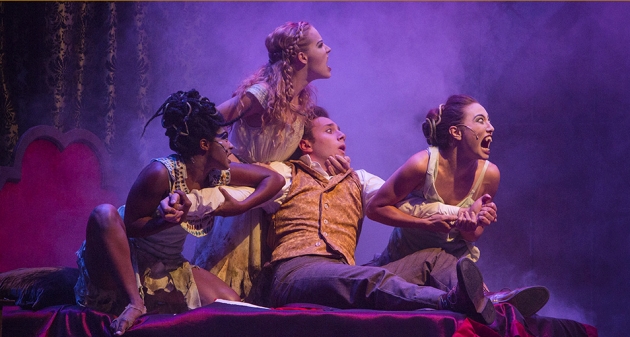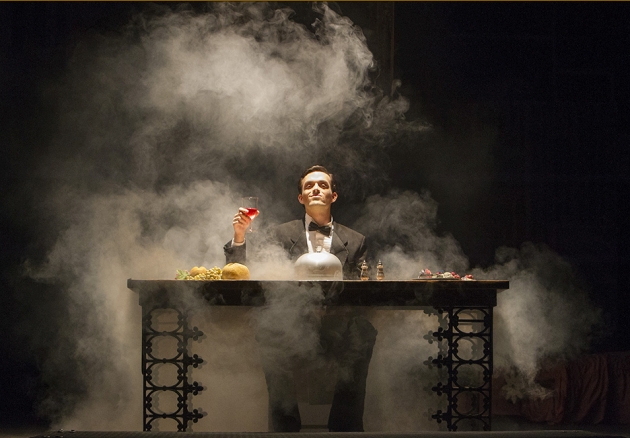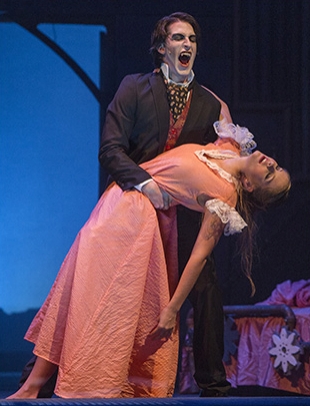Publisher's note: The author of this post, Kathryn Kennedy, is a contributor to ECU News Services.
ECU students bring Dracula back from the dead
Two days before the opening night of "Dracula," in a backstage dressing room at McGinnis Theatre, costume designer Cybele Moon cocked her head and sized up a white, lacy wedding gown. Dissatisfied, she snatched it from the rack.
"This dress needs more blood," she said, and hauled it back downstairs to the costume shop.
With plentiful blood and smoke, vampire vixens and Victorians, Halloween has come early to East Carolina University. The ECU/Loessin Playhouse production of "Dracula" opened Sept. 26 and runs through Oct. 1, including a Sunday matinee. Tickets are $8 for youth/students and $10 for the general public.
Based on Bram Stoker's classic horror novel, "Dracula" tells the story of the ancient vampire Count Dracula's arrival in London and the attempts to piece together the clues of his mysterious appearance. The secrets characters keep from one another allow Dracula's reign of terror to continue, resulting in a hideous fate for some.
Faculty member Greg Funaro directs the play. It's the first production of Dracula at ECU since the 1970s, and the first horror play performed in Funaro's 13-year tenure at the university. The director said he's been fascinated with Dracula since, as a fifth grader, he saw the 1979 film version starring Frank Langella.
The immortal vampire Count Dracula, played by Landon Summers, feeds on the blood of London resident Lucy Westenra, played by Cate Kessler.
"It's a fun play," Funaro said. "It's something that is open to all these different imaginings... and it also features one of the world's first and enduring supervillains. He says he's capable of love, but he's just pure evil. He's got so many strengths, but so many weaknesses, too. There are such interesting layers to him."
ECU senior Landon Summers was selected for the title role of Dracula, with other lead roles including junior Anne-Marie Kennedy and senior Robert DiDomenico as Mina and Jonathan Harker.
For this particular production, Funaro selected the well-known adaptation by playwright Steven Dietz. It's the truest to the original novel, he said, which is made up of letters and journal entries rather than a strictly chronologic narrative.
"Now (vampires) are such a cliché, it's a great challenge to take something that's so overdone and keep it fresh and interesting," Funaro said, "without being hokey."
Dracula needs a Transylvanian accent, for example, but shouldn't sound like the count from "Sesame Street," Funaro explained.
The ECU production also incorporates a growing literary science fiction/fantasy genre known as "steampunk," which has been described by some as what the future would have looked like if it happened sooner - specifically, in the Victorian era. It was an interesting period in history, Funaro said, when Victorian restraint confronted advances in science, philosophy and technology.
Faculty member Jeni L. Parker's set includes massive gears, steam grates and pipes alongside Transylvanian castle walls. Moon's costumes include corsets worn outside rather than underneath dresses, more color than traditional Victorian clothing, and funky, metallic trim on jackets and vests.
This is the first ECU production with costume direction by Moon, who arrived on campus Aug. 2. She said she was prepared for the challenges of caring for costumes bloodied nightly but, she added, "it is my first show with fangs."
The ECU/Loessin Playhouse is the educational theater for the School of Theatre and Dance's professional programs. Students are involved in every part of the production, not only as actors. Its mission is to provide the citizens of eastern North Carolina with the highest quality productions of the world's musical, comic and dramatic repertory at affordable prices to encourage broad, diverse and non-elitist audience participation.
For more information about "Dracula," visit
http://www.ecu.edu/theatredance/productions/, and for tickets visit
www.ECUARTS.com or call 1-800-ARTS.
The many incarnations of "Dracula"
From Sept. 26 through Oct. 1, Count Dracula will stalk McGinnis Theatre - primarily after dark, of course - as ECU's School of Theatre and Dance presents a production of "Dracula" adapted for the stage from Bram Stoker's famous 1897 novel.
Count Dracula is most famous vampire in history, and the story of a undead Transylvanian nobleman who travels to London to seek out, seduce, and suck the blood from beautiful young women, while being able to turn himself into a bat, a rat or a wolf and proclaim the glories of "the children of the night," is known by almost everyone - even those who have never read the novel. This is because Dracula has been kept undead through his countless re-appearances in film and on stage. It's hard to keep a good vampire down.
Dracula has "lived" in the theater for his entire unlife. Upon the publication of his novel, Stoker staged a reading of the story to secure the theatrical copyright to his tale. In 1924, the author's widow commissioned Hamilton Deane to write a dramatic adaption of the novel that toured England before becoming a hit in London.
In 1927, Dracula came to Broadway, starring Bela Lugosi, a then little-known actor. The play was a success, toured the United States and has been touring ever since. The most famous adaptation was the 1977 Broadway revival with set and costume designs by Edward Gorey and starring Frank Langella as a seriously sexual vampire.
Adaptation is the sincerest form of cinema, and as he was appearing on stage he began to be seen in darkened movie houses. Some of the most interesting horror films ever made are adaptations of "Dracula." F.W. Murnau's 1922 "Nosferatu" starring Max Schreck is one of the finest silent films ever made.
Tod Browning's 1931 "Dracula" with Lugosi and Edward Van Sloan created the image of the caped count who has become such a cultural icon that he was even transformed into the "Sesame Street" Count von Count.
In the 1950s British adaptations of "Dracula," Christopher Lee frightened a generation of filmgoers with his threateningly forceful portrayal of the count. Frank Langella reprised his Broadway role for BBC television in 1979 as a suave seducer confronted by Sir Laurence Olivier as vampire hunter Professor Van Helsing.
The most elaborate adaptation has been Francis Ford Coppola's 1992 operatic "Bram Stoker's Dracula," starring Gary Oldman, Winona Ryder, and Anthony Hopkins. The less said about "Billy the Kid vs. Dracula" and "Dracula's Dog," the better.
Wherever he has appeared Dracula has entertained, seduced, and frightened audiences. And now he is amongst us. Beware and buy garlic.
- Jim Holte, professor of English and Film Studies at ECU

Vampire vixens, left to right, Demetra Drayton, Jillian Brocki and Elizabeth Graves attack London resident Jonathan Harker – played by Robert DiDomenico – during an overnight stay at Count Dracula's castle in Transylvania.

Count Dracula's faithful servant Renfield, played by Cody Schauble, sits at his dinner table at the opening of "Dracula," a student production by the ECU/Loessin Playhouse.

























